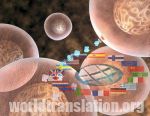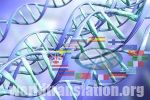Aging genes

Japanese, American and British biologists have discovered a mechanism in the mouse genome, which inclusion has led to the transformation of rodent healthy muscles in old muscles, results of their experiments, they published in the journal Cell.  The genome of humans and other mammals contains a large number of "instructions" which control the organism during it growth, vital activity and aging. It is believed that the study of the genetic mechanisms, which turned on during aging, help to prolong youth and life. Scientists were able to single out many genes which are responsible for these processes, but none of them suited to be the " aging gene" or " gene of eternal youth."
The genome of humans and other mammals contains a large number of "instructions" which control the organism during it growth, vital activity and aging. It is believed that the study of the genetic mechanisms, which turned on during aging, help to prolong youth and life. Scientists were able to single out many genes which are responsible for these processes, but none of them suited to be the " aging gene" or " gene of eternal youth." A group of biologists from the University of Osaka, Japan have discovered one of the key elements that control the process of aging. The discovery was made when they studying the work of the two genetic mechanisms - Clq protein complex and the Wnt system.
A group of biologists from the University of Osaka, Japan have discovered one of the key elements that control the process of aging. The discovery was made when they studying the work of the two genetic mechanisms - Clq protein complex and the Wnt system.
As the researchers have explained, these mechanisms provide several tens of proteins and genes which transmit, process and respond to chemical signals. Wnt system manages the processes of development of the organism during its growing, and it fault becoming one of the causes of cancer. The protein complex Clq is involved in the work of immune system, but far not all of its functions are known to biologists.
Wnt system manages the processes of development of the organism during its growing, and it fault becoming one of the causes of cancer. The protein complex Clq is involved in the work of immune system, but far not all of its functions are known to biologists.
Several groups of biologists noticed that the main  role in the aging process of mammalian organism plays Wnt system. Thus, the suppression of activity of this system "brought back" young for muscles and bones of elderly mice. However, the mechanisms that control the Wnt, still remained a mystery to scientists.
role in the aging process of mammalian organism plays Wnt system. Thus, the suppression of activity of this system "brought back" young for muscles and bones of elderly mice. However, the mechanisms that control the Wnt, still remained a mystery to scientists.
As Japanese scientists noticed, the growth of activity of  Wnt system in the cells of elderly mice is accompanied by increasing of Clq protein concentration. Scientists have made the assumption that the Wnt system and launching of the mechanism of aging are activated with the help of this substance.
Wnt system in the cells of elderly mice is accompanied by increasing of Clq protein concentration. Scientists have made the assumption that the Wnt system and launching of the mechanism of aging are activated with the help of this substance.
To verify the correctness of the assumption, the researchers grew the culture of mice and humans muscles, and added a large number of molecules of Clq in the nutrient medium. A few hours later, biologists noticed that on the cell surface molecules of protein complex united with Fz receptors - one of the components of the Wnt system. As the scientists told, increasing the concentration of Clq molecules in the nutrient solution led to the growth of the activity of Wnt system in the cells, which was a confirmation of biologists guesswork. After they were convinced in the truth of the hypothesis, the researchers tried to artificially age the muscles of young rodents in the muscles of old mouse.
As the scientists told, increasing the concentration of Clq molecules in the nutrient solution led to the growth of the activity of Wnt system in the cells, which was a confirmation of biologists guesswork. After they were convinced in the truth of the hypothesis, the researchers tried to artificially age the muscles of young rodents in the muscles of old mouse. The researchers conducted experiments on young rodents, which were divided into 2 groups. They glued the gel patch on the feet of mice of the first group , the patch was impregnated with molecules of the protein complex and the second group of rodents was the control one.
The researchers conducted experiments on young rodents, which were divided into 2 groups. They glued the gel patch on the feet of mice of the first group , the patch was impregnated with molecules of the protein complex and the second group of rodents was the control one.
A few days later the scientists burned the feet of laboratory rodents with liquid nitrogen and estimated the rate of recovery of tissues. As it turned out, the muscles of mice with a plaster recovered very slowly, their structure was more similar to the muscles of elderly rather than young rodents. Muscle tissue of mice in the control group recovered normaly. Scientists believe that their discovery will help in the development of drugs that will suppress the activity of Wnt.
Scientists believe that their discovery will help in the development of drugs that will suppress the activity of Wnt.
"Our task is that the medicine against aging suppressed the activity of the Clq protein complex, which amount in cells of an organism increases with aging. Received results of research brought us nearer for one more step to the realization of the dream of all humanity - the prevention of aging", - said biologists in their interview for Kyodo agency.
Video: "The aging process in 40 seconds"